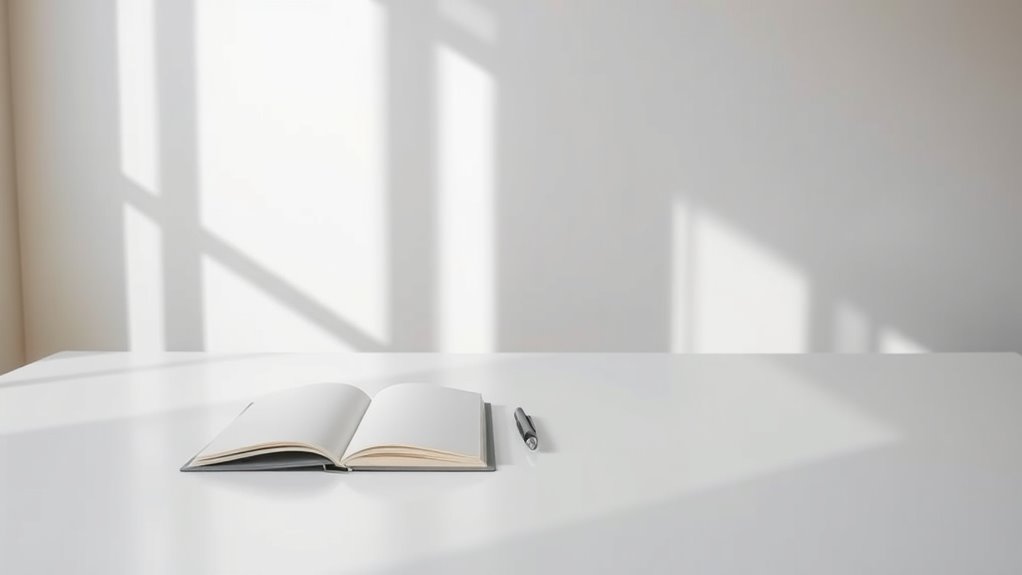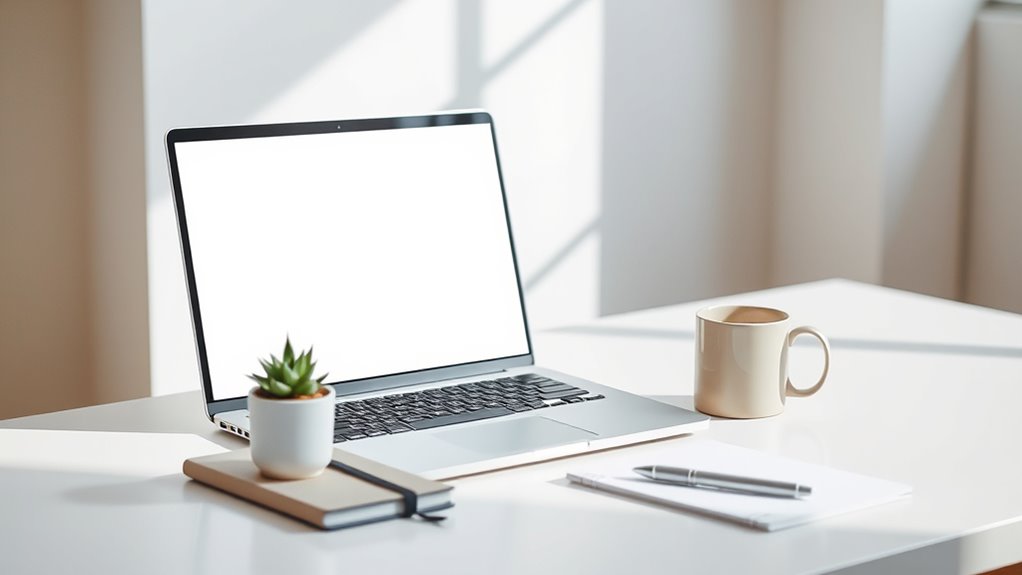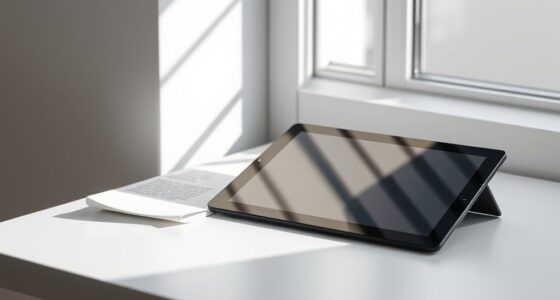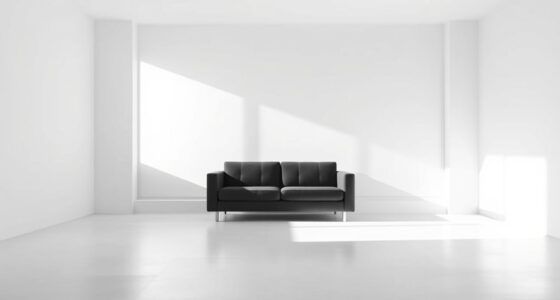To keep your inspiration flowing without the mess, embrace minimalism by simplifying your workspace and digital environment. Keep only the essentials—favorite tools, meaningful objects, and key files—while removing clutter that distracts you. Organize digital files and unsubscribe from unnecessary emails to stay focused. A tidy space clears your mind and sparks creativity, making ideas easier to develop. If you want to discover more ways to foster your creative space, keep exploring how minimalism can transform your inspiration.
Key Takeaways
- Maintain a clutter-free workspace by regularly removing unnecessary items, fostering mental clarity and focus.
- Organize digital files with folders and labels to reduce distractions and enhance accessibility.
- Keep only essential tools and meaningful objects, creating an environment that encourages experimentation and inspiration.
- Limit digital notifications and unsubscribing from distractions to sustain deep concentration.
- Design an intentional, simplified space that promotes mental clarity and allows ideas to breathe and grow.

Have you ever wondered how simplifying your environment can boost your creative flow? When your surroundings are cluttered or chaotic, it’s easy to feel overwhelmed, distracted, and uninspired. Creating a minimalist environment isn’t about stripping away all your possessions; it’s about intentionally designing a space that fosters focus and sparks your imagination. Your creative workspace should be a sanctuary where ideas can flourish without interference. Start by clearing off your desk of anything that doesn’t serve a purpose or inspire you. Keep only the essentials—your favorite tools, a notebook, maybe a few meaningful objects. When your workspace is clean and organized, your mind feels lighter, and it’s easier to dive deep into your projects.
A clutter-free workspace sparks focus and ignites your creative imagination.
Digital decluttering is equally important. Our devices are sources of endless distraction, filled with notifications, apps, and files that can clutter your mind just as much as physical clutter can clutter your desk. Take time to organize your digital environment—delete unnecessary files, unsubscribe from distracting emails, and set clear boundaries for your screen time. Use folders and labels to keep your digital workspace tidy, making it easier to access what you need without sifting through chaos. This process not only clears space on your devices but also clears mental space, freeing you to focus on your creative pursuits.
Minimizing distractions through digital decluttering can markedly enhance your productivity. When you’re not constantly interrupted by alerts or scrolling through irrelevant content, you can enter a state of flow more easily. This clarity allows your ideas to develop without interruption, and your creative energy stays directed toward meaningful work. Think of your digital tools as an extension of your physical environment—keeping both organized helps you maintain focus and stay inspired. Additionally, choosing high-quality projectors can transform your creative space into an immersive environment that fuels your imagination.
Embracing minimalism in your creative workspace and digital life isn’t about perfection or deprivation. It’s about creating an intentional space that promotes your best work. When your environment is simplified, you free yourself from the mental clutter that can stifle creativity. This approach allows your ideas to breathe and grow, giving you more space to experiment and innovate. Ultimately, by consciously decluttering both physically and digitally, you cultivate a mental landscape where inspiration can thrive without the mess.
Frequently Asked Questions
How Can Minimalism Boost My Creative Productivity?
Minimalism can boost your creative productivity by encouraging creative decluttering and fostering visual simplicity. When you clear out unnecessary clutter, your mind can focus better and generate fresh ideas without distraction. Embracing visual simplicity in your workspace helps you stay organized and inspired, making it easier to access your creative tools. As a result, you’ll find yourself more productive, motivated, and able to keep your inspiration flowing effortlessly.
What Are Common Pitfalls When Adopting Minimalism?
You might find that clutter reduction and aesthetic consistency are harder than they seem. Common pitfalls include over-simplifying, which can strip away your creative spark, or cluttering your space again because you didn’t establish clear boundaries. Sometimes, you think minimalism is just about less, but it’s about intentional choices. Be cautious—it’s easy to revert to old habits or create a sterile environment that stifles inspiration.
How Do I Balance Inspiration and Simplicity?
Balancing inspiration and simplicity means you need to focus on organizing inspiration effectively while reducing distractions. You can do this by creating designated spaces or tools for your ideas, so inspiration stays accessible without cluttering your mind. Limit your sources of distraction and set time aside for focused work. This way, you keep your environment simple, while still nurturing your creativity and staying inspired without feeling overwhelmed.
Can Minimalism Work for All Creative Fields?
You might be surprised, but minimalism can work for all creative fields. When you adopt a minimalist mindset, you naturally reduce creative clutter, allowing your ideas to breathe and flourish. Whether you’re a painter, writer, or musician, simplicity helps you focus on what truly matters. By stripping away excess, you create space for inspiration to flow effortlessly, proving that minimalism isn’t one-size-fits-all—it’s adaptable and beneficial across all creative pursuits.
What Tools Help Maintain a Minimalist Creative Workspace?
To maintain a minimalist creative workspace, you need effective tools that promote digital decluttering and tool organization. Use apps like Trello or Notion to keep your projects streamlined, and regularly delete unnecessary files or emails. Invest in storage solutions like drawer organizers or cable management systems to keep physical tools tidy. These strategies help you stay focused, reduce clutter, and foster a clear environment that sparks creativity without distraction.
Conclusion
By embracing minimalism, you clear the clutter and make room for true inspiration. But beware—every piece you let go of opens a space for something unexpected. As you step into this streamlined world, what hidden ideas will surface when the noise fades away? The future of your creativity hinges on these choices. Keep it simple, stay open, and watch as your imagination begins to unseal secrets you never knew existed. The next masterpiece awaits.









